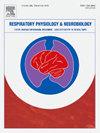猫气管支气管树重复机械刺激时咳嗽运动输出的变化
IF 1.6
4区 医学
Q3 PHYSIOLOGY
引用次数: 0
摘要
缺乏气道保护反应是预测肺部发病率和死亡率的重要因素。我们研究了在重复刺激方案中机械引起的咳嗽运动输出的变化,这可能发生在吃饭时吸入食物/液体的过程中。记录猫在气管反复机械刺激时膈肌和腹肌肌电图的发生、幅度、相位持续时间、功率谱特征以及咳嗽时的食管压力。初始咳嗽兴奋性升高后,气管重复刺激导致咳嗽次数、肌电图和食管压力值降低,符合指数模型。咳嗽期持续时间变化不大。此外,连续气道刺激的暂停(持续几分钟)导致咳嗽进一步减少,与咳嗽期持续时间延长有关,但在一次额外的刺激试验后得到解决,与长潜伏期短暂性抑郁一致。功率谱分析表明胸骨旁肌肉运动单元的补充发生了变化,尽管咳嗽了数百次,但没有出现疲劳的迹象。我们的结果与中枢适应机制的存在是一致的,该机制可以调节重复性咳嗽的兴奋性,可能与短暂增强和抑郁重叠。该结果具有预测呼吸道疾病气道保护反应的机制意义。本文章由计算机程序翻译,如有差异,请以英文原文为准。
Changes in cough motor output during repetitive mechanical stimulation of the tracheobronchial tree in cats
The lack of airway protective responses is highly predictive of pulmonary morbidity and mortality. We investigated changes in motor output of mechanically induced cough during a repeated stimulation protocol, as may occur during aspiration of food / liquid over a meal. The occurrence, magnitude, phase durations, and power spectra characteristics of diaphragm and abdominal muscle electromyograms, and esophageal pressures during coughing were recorded during repeated mechanical stimulation of the trachea in cats. After the initial increase in cough excitability, repeated tracheal stimulation resulted in reduced cough number, electromyograms and esophageal pressure magnitudes, which fit an exponential model. There was little change in cough phase durations. Additionally, a pause in sequential airway stimulation (lasting several minutes) resulted in a further cough reduction, associated with prolongation of cough phase durations, but was resolved after one additional stimulus trial, consistent with long-latency transient depression. Power spectral analysis suggested changes in recruitment of motor units for parasternal muscles and no signs of fatigue although hundreds of coughs were executed. Our results are consistent with the presence of central adaptive mechanisms that can regulate the excitability of repetitive coughing, likely overlapping with transient potentiation and depression. The results have mechanistic implications for predicting airway protective responses in respiratory diseases.
求助全文
通过发布文献求助,成功后即可免费获取论文全文。
去求助
来源期刊
CiteScore
4.80
自引率
8.70%
发文量
104
审稿时长
54 days
期刊介绍:
Respiratory Physiology & Neurobiology (RESPNB) publishes original articles and invited reviews concerning physiology and pathophysiology of respiration in its broadest sense.
Although a special focus is on topics in neurobiology, high quality papers in respiratory molecular and cellular biology are also welcome, as are high-quality papers in traditional areas, such as:
-Mechanics of breathing-
Gas exchange and acid-base balance-
Respiration at rest and exercise-
Respiration in unusual conditions, like high or low pressure or changes of temperature, low ambient oxygen-
Embryonic and adult respiration-
Comparative respiratory physiology.
Papers on clinical aspects, original methods, as well as theoretical papers are also considered as long as they foster the understanding of respiratory physiology and pathophysiology.

 求助内容:
求助内容: 应助结果提醒方式:
应助结果提醒方式:


